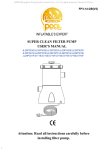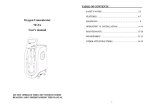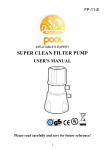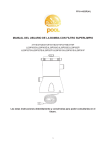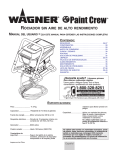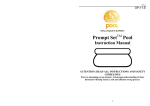Download Shanghai Jilong Plastic Products Z-ray Iseries Instruction manual
Transcript
BB- II -10-E Z-ray II Instruction Manual IMPORTANT SAFETY GUIDLINES FOR SPORT BOAT USE Please read & understand prior to using your boat 1 TABLE OF CONTENTS Introduction ……….……...…………..…….……………..…….… 3 Important Safety Guideline …….……..…….…………………..… 4-5 Sketch Map ………...……………………………………………… 6 Information (Basic data & Accessories)………..……..…………… 7 Installation Illustration …………...........…………………………... 8-11 Operating instructions ………...................………………………… 12-13 General Maintenance ..................................……………………… ..14 Disassembly ………………..……………………………………… 14 Repairs ………………..…………………………………………… 15 Trouble Shooting Guide …………………………...……………… 15 Warranty ………………………………...………………...………..16 2 Introduction We thank you for your purchase of our Z-ray II series. We think you will find it quite simple to install and use efficiently. Please read the following instruction carefully before using this inflatable boat and keep the instruction for future reference. If you re-sell the craft, please hand this manual over to the new buyer. ThisZ-ray II inflatable boat has been manufactured to the highest quality standards. Including the following features: z Easy installation and maintenance z Low cost on maintenance and operation z Offer quiet and high quality performance z Quality certified construction z Reliable, corrosion-proof and reinforced material z Elegant and delightful design z Easy to store and compact for winter z GS certificated boat z Safe to use and environmentally friendly ThisZ-ray II inflatable boat manual will provide you with all of the easy instructions you need to follow in order to set up and operate this boat efficiently. If this is your first craft, or you are not familiar with this type of boat, please ensure that you obtain handling and operator training before operating the craft. Your dealer or national sailing federation or yacht club will be pleased to advice you of local sea school, or competent instructors. In addition to set-up instructions and operational guidelines, we have also included several very important Warning and Caution statements that pertain to the safe use and enjoyment of this newZ-ray II inflatable boat. It is very important that you take the time to read them all and share them with any individuals that will ultimately be enjoying the use of this boat. Please make certain that you read and understand the information contained in this Manual prior to initial use. Please retain this Manual for future reference! 3 Important Safety Guideline Please read & understand prior to using boat To enhance the enjoyment of your boat and protect the safety of the operator using the product, ALWAYS STRICTLY OBSERVE the following important safety points. These should be read and understood prior to use: 1. WARNING: Boat designed for voyages in sheltered water only. Please only use the craft on small lakes, rivers and canals where conditions up to a wind force of level 4 and wave height up to 0.5m. 2. WARNING: This is not a life saving device. Use only under competent supervision. Never allow diving or jumping into this product. Never leave in or near the water when not in use. Never tow from any other craft. Adult assembly and operation required. 3. WARNING: Inflating the product’s chambers should be as the numbered sequence and do not over inflate. Excessive inflation of the product can cause the chambers to burst or cause damage to the welded seams. 4. WARNING: It is highly recommended that a user should take a boating safety course and get hands-on training from your boat dealer or local boating authorities. Review all safety requirements regularly. Never navigate alone. 5. WARNING: A Personal Flotation Device (PFD) is required for each passenger. It is especially important that children and non-swimmers wear a Personal Flotation Device at all times. Children and nonswimmers need special instruction in the use of Personal Flotation Device. 6. WARNING: Use caution when stepping or climbing aboard the boat Step into the center of the boat for maximum stability. Distribute the weight of load and accessories evenly so that the boat sits level fore to aft and side to side. 7. WARNING: Do not use your boat if you suspect a puncture or leak. It may be unsafe. 4 8. WARNING: Beware of offshore winds and under-currents. These could be unsafe conditions. 9. WARNING: The total number of persons and total weight shall not exceed the information printed on the boat. Do not exceed the maximum recommended capacities. Overloading violates regulations 10. WARNING: It is the responsibility of the boat operator to identify and obey all local and state laws pertaining to boat safety and required safety equipment. Please consult your local authorities to ensure compliance. 11. Do not allow unattended children in the boat. Always make sure that at least one responsible adult is supervising all children and those who do not know how to swim AT ALL TIMES. 12. Always maintain the proper boat safety equipment in an easily accessible area in your boat. Clearly post emergency phone numbers as well as safety advisories and rules (such as “No Jumping or Diving”). 13. Boat is designed to be storable, seasonal boat. If you live in a temperate area in which the boat will not be in use all year-round, it is STRONGLY RECOMMENDED that you deflate the boat and dry it thoroughly, and store it in a protected area for the off-season. This will help extend your boat and prevent a safety hazard from developing while the boat is not in use. 14. WARNING: Certain household cleaning solvents, chemicals and other liquids (such as battery acid, oil and gasoline) could damage the PVC fabric. In the event of spill or mishandling, you should check for leaks and inspect for structural integrity. 15. Follow these rules to avoid drowning, paralysis or other serious injuries. 5 Sketch Map High Strengh Nylon Safecy Grab Rope High Pressure Valve Quick Assembly Wooden Bench Seat System PVC-Anti-Bump Protective Strake Heavy Duty PVC Swivel Oarlock Durable And Stronge Aluminum Floor Board Drain Valve Compliance Plate Marine Ply Motor Transom Carring Handle PVC Cpne 6 Basic data Item No. JL007013-2N Z-ray II Model No. 500 365 x 205cm (144˝ x 81˝) Deflated Size Inflatable Size Max. Power of motor Capacity (Person) Max. Load Weight(kg) 360 x 170 x 44cm (142˝ x 67˝ x 17.5˝) 9.9 HP 7.4 kw 5 600 kg 1321 Lbs Accessories Ref. Description Diagram QTY 1 Boat Body See P6 1 2 Repair Kit 1 3 Hand pump 1 4 Oar 2 5 Bench Board 2 6 Pressure Gauge 1 7 Storage Compartment 1 8 Seat Cushion 1 7 Installation 1. Find a flat area and make sure that the surface you have selected to set up the boat is completely free of stones, sticks, sharp objects or other foreign debris. 2. Carefully unfold the boat, spreading out the tubes and floor to make them as smooth as possible. NOTE: For ease of install, it is preferable to set up the boat on a warm and sunny day. If time permits, expose the unrolled boat to direct sunlight for 1 hour or more, so that the boat material will be more flexible during installation. CAUTION: DO NOT DRAG THE BOAT, AS IT MAY TEAR THE BOAT OR CAUSE OTHER DAMAGE. We will not be held responsible for damage caused to the boat due to mishandling or failure to follow these instructions. 3. Install the Z-ray II floor in numbered sequence. Number (1) is a wooden board, numbers (2), (3) and (4) are aluminum. When number (1) is in position, slide number (2) up to number (1) and insert the leading edge of number (2) into the grooved rear of number (1). Position the number (3) leading edge into the grooved rear of number (2). Position the rear edge of number (4) into the back of the boat. Lift the rear edge of number (3) to the front of number (4). Both lifted above the floor, connection of (3) and (4). Adjust each board to live up down each side fix the sides lock bars into position with the wide side up. Adjust until the side lock bars slide onto the floor boards. 8 4. Wooden bench seat installation: Insert the plastic (or wooden) rods into the seat retaining tubes (E). Side the seat into position by inserting the retaining tubes into the grooves located at each end of bench seat. Insert into both ends of the seat at the same time (F) and (G). Position the seat to be in the middle of the retaining tubes. 5. Inflate the boat’s chambers in numbered sequences (1) and (2) then (3), (4). It is very important to follow the numbered sequence: failure to do it could result in an improperly inflated boat. You can use a hand or foot operated air pump, or a low pressure electric pump to inflate the boat. Do not use high-pressure air compressors. Inflate each air chamber in number sequence until all chambers are full. Warning: Do not over inflate in one time; it is harmful for the boat body. And over inflation of the chambers can cause the boat to burst or cause damage to the boat body’s seams. Please see the below illustration for the detailed inflated and deflated operation for Built-in Safety Valve. 9 a) Inflation: Unscrew the Valve Cap A, Assemble the Inflation Adaptor with the Inflating Mouth B, Air pressure Meter and the air pump (Please see the below detailed illustration!). Air Pressure Meter Assembled with Assembled with Inflating Mouth B Air Pump After the inflation adapter is assembled completely, you can inflate the boat by number sequence. Do not over inflate. After inflating, screw the Valve Cap A in clockwise direction by hand. Caution: Do not over inflate or use high-pressure pump. The maximum pressure for air chamber number (1) and (2) should be 0.25bar (3.63PSI). And the maximum pressure for air chamber number (3) should be 0.25bar (3.63PSI). The maximum pressure for air chamber number (4) should be 0.35bar (5.08PSI). b) Deflation: Remove the Valve Cap A, push down the Deflation Button 。 C and turn the valve in clockwise direction by 90 until it is locked, release the valve and the air will flow out. If you want to stop deflation, push down the Deflation Button C and turn it in 10 。 counter-clockwise direction by 90 . The deflation will stop when the valve is released. 6. Oars Assembly: Assemble the section of the oar by depressing the spring loaded pin and inserting the sections of oar until the pins lock into their retaining holes. 7. Oars Installation: Insert the bolt on the swivel oarlock into the central hole on the oar shaft. Screw the retaining nut onto the end of the bolt and position the oar into the oar holder. 8. Motor Installation: To fit a motor onto the motor board please follow the instructions of your Motor Installation Manual. 11 Operating Instruction I) Preparation before departing: 1. Acquire necessary information and inform other passengers: A) Get information on local laws, regulation and hazards related to water activities and boat operation. B) Check weather forecast, local currents, tides and wind conditions. C) Advise someone on land of the time you plan to be back. D) Explain basic boat operation to all passengers. E) Be sure that at least one of your passengers can operate the boat in case of emergency. F) Learn how to determine the distance you can cover, and remember that bad weather conditions can alter this. 2. Check the working condition of the boat and equipments: A) Check inflation pressure. B) Inspect all safety valves. C) Check the load is evenly distributed on deck of boat: fore to back and side to side. D) Only motor powered up to the size on the table is recommended for this boat. (Please check the recommended maximum motor power on Page N0.7) 3. Check that required safety equipment is on board (check the laws and regulations of the country or locality in which you are boating): A) One personal flotation device (PFD) for each passenger. B) The air pump, oars, repair kit and tool kit. C) The mandatory equipment. D) The boat papers and your boating license (if applicable). E) Lights are required if operating after dark. 12 II) Rules to observe during navigation: 1. Be responsible and strictly follow the safety rules. Do not neglect the safety rules. This could hazard your life and the lives of other passengers. 2. Learn to always keep control of your boat. 3. Respect local regulations and practices. 4. Remember weather conditions can rapidly deteriorate. Always be sure that you can reach a shelter rapidly. 5. Each person on boat always wears a personal flotation device. 6. Do not drink or take drugs before or while operating your boat. All passengers should maintain sobriety at all times. 7. Keep fire away. Do not smoke on board. 8. Do not overload the authorized number of persons or total weight. 9. Make sure your passengers remain seated. If the boat is at rest or at low speed, passenger can sit on the buoyancy tubes and grab the line around the boat. At planning speed, in rough water or during sharp turns, all passengers should position themselves in seats or on the floor. 10. No riding at bow. Bow riding is illegal in most areas and it is extremely dangerous. 11. Be especially careful when docking. Arms and legs may be injured if they are outside of the boat. 12. Always avoid areas where divers or swimmers are in the water. Keep a sharp lookout especially when operating near beaches and launch sites. The afloat flag indicates proximity of divers. You MUST stay at a good distance (minimum 50 meters). 13. Avoid sharp turns at high speeds, which may turn the boat over or throw passenger out of boat. 13 General Maintenance 1. Depending on the parts usage, keep some spare available, all parts suggest must consult local agent for factory authorized parts when servicing system. 2. Clean your boat after a trip to prevent damage from sand, salt water or such exposure. 3. No lubrication or regular mechanical maintenance is needed. 4. Wash outside of the boat with a mild detergent and water, or use the sponge and mild soap. It can clean most dirt. 5. Do not use solvents to clean the boat, solvents may damage material or plastic components in system. 6. Make sure the boat is completely clean and dry before storing, otherwise mold can accumulate or boat will be mouldy. 7. Store all boat’s accessories in a dry storage location and with ventilation. Make sure all parts are dry before storage. 8. You can store the boat in a dry location and take advantage of the original packing carton for storage for next season use. Do not store in an area where it is likely to be exposed to extreme temperature. Disassembly 1. Remove all the accessories (fishing rod, oars, gear pouch...) from the boat. 2. Open all valves and deflate boat completely. 3. Fold the boat. (Make sure the boat is clean and dry. See the above General Maintenance chapter.) 4. Put boat and air pump, oars into carry bag for storage. 14 Repairs Little holes or punctures can be repaired with the repair kit come along with the boat. 1. Find the leak on the boat first. 2. Thoroughly clean the area surrounding the leak to remove any dirt or grime. 3. Cutting a piece of repair material in round shape, that should be larger than the damaged area. 4. Using a pencil, trace the outline of the patch lightly. 5. Apply adhesive to the underneath side of the patch and around the area to be repaired. Coat the affected area lightly but completely with glue. 6. Put the repair patch on the damaged area and press down firmly. 7. Allow 12 hours for repair to dry. After repair patch has dried, apply glue around the edges for a complete seal (dry 4 hours). 8. You boat can safely use after the above steps. Trouble Shooting Guide When you find the boat appears a bit soft, it might not definitely be because of a leak. Firstly you can check if the Built-in Safety valve (check A, B, C and D assemble condition) and other valves are loose. If all valves are in good condition, you can consider if it is caused by temperature variation: If the boat was inflated in the day at higher temperature and the temperature cools down at night. The pressure in the chambers may be less, and the boat may appear soft. If the valves and temperature variation are not the reasons, you need to start looking for a leak: z z z Inflate the boat and look and listen for leaks. Any large leaks should be clearly visible. To pin point the location of the leak: spray mild soapy water over the suspicious areas. Any leak will produce bubbles. Check valves for leaks. 15 LIMITED WARRANTY ATTENTION CUSTOMER - Please read this statement carefully and keeps your original store receipt along with this warranty certificate at all times. Your receipt is required as proof of purchase and to verify the length of your product ownership. We warrant all components contained in this product against defects in materials and workmanship under normal use and service, for a period of 730 days from the date of purchase for the original owner only. If any of the components have been consumerreplaced, damaged, or misused, the corresponding warranty on those components is invalidated. In this situation, you will be advised of the cost of replacement parts and processing instructions. Please register warranty within 30 days of purchase on www.jilong.com in order to validate your warranty. If a verifiable manufacturing defect is found during the relevant time period, we agree to repair or replace at its option any product under warranty provided proper proof of purchase is presented. This limited warranty is not valid if the product is used for commercial purposes, or if the damage is caused by an accident, an act of God, consumer misuse, neglect or abuse, vandalism, improper use of chemicals, exposure to extreme weather conditions or negligence during product set up or disassembly. We cannot be held responsible for the cost of installation, labor, or transportation expenses incurred due to the replacement of defective parts. This limited warranty, furthermore, does not cover any unauthorized alterations to the product. Shanghai Jilong Plastic Products Co. Ltd. No. 460 Lanxue Road, Huanglou, Pudong Area, Shanghai, 201205, P.R. China Tel: +86-21-58942200 E-mail: [email protected] Web: www.jilong.com After Sales Service For EU Countries: Jilong Europe Srl unipersonale Via Vitaliano Brancati 44, 00144, Roma Italy E-mail: [email protected] After-sales service for North America : #140 - 13988 Maycrest Way Richmond B.C., V6V 3C3 Canada E-mail [email protected] Tel. 1-604-244-8110 Toll Free Tel. 1-866-946-3002 Toll Free Fax 1-866-403-7286 16
















